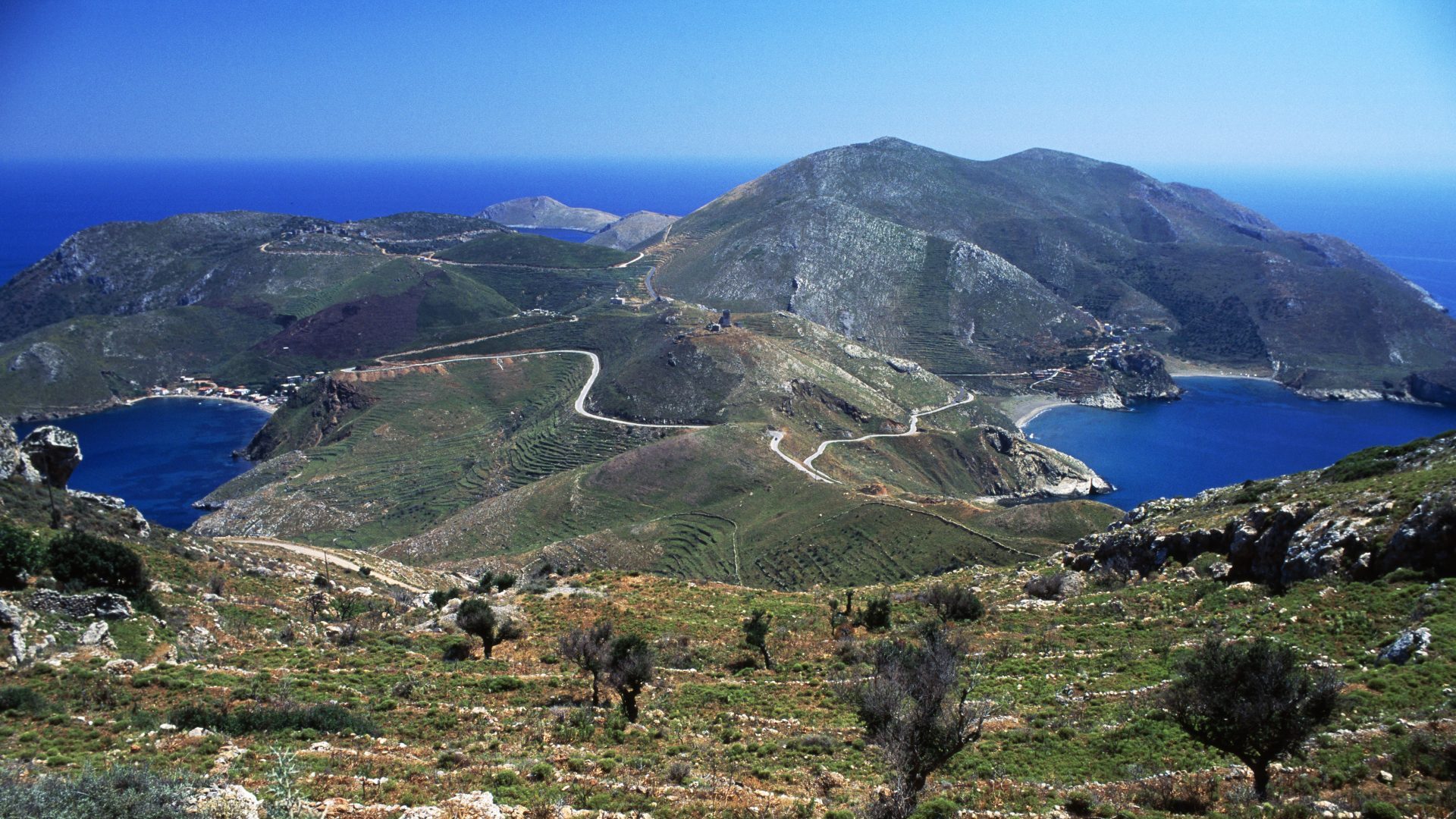“There was not a single school in the Mani until the 1830s, and it is without a doubt the most backward part of Greece,” wrote the highly esteemed travel writer Patrick (later Sir Patrick) Leigh Fermor in 1958, after walking through the mountains into this lost landscape of the remotest Peloponnese. “Hence the almost total absence of literature and culture. The sombre traditions of the region continued unhindered for centuries. There are other symptomatic observances of these traditions apart from the general concentration on death and revenge.”
Leigh Fermor, whose passion for all things Greek (he worked behind the
lines for the Cretan resistance) echoed that of Lord Byron more than a
century earlier, was nonetheless drawn to both the people and the place
to the extent that he and his wife, Joan, built a house and lived the latter half
of their lives there.
The Mani droops on the map from the Peloponnese mainland like the deflated middle finger of an old glove. In the case of the Mani, feudal legacies endure and the younger and more ambitious have long fled its mean
fields for an easier life in Athens or Piraeus. They have left behind the crumbling masonry of about 800 tower houses – mini-castles that rise almost seamlessly from the limestone. This is not the sculpted shimmering white limestone synonymous with the gently rolling landscape of the Yorkshire Dales; it is jagged and ominous, punctuated by prickly pears, stained black and scraped into low walls to permit space for the occasional olive grove.
And yet, more than 60 years after Leigh Fermor first set foot here, the landscape continues to exert a curious pull for many. Some insist the Maniots are descended from the citizens of Sparta, and the far-right Golden Dawn movement sees them as the true manifestation of the Greek fatherland. But the history is curiously uncertain: others refer to a migration south of Franks fleeing the Byzantine siege of the city of Nykli. As the refugees competed for the scarce natural resources of the Mani, a system of
feudal battle and vendettas evolved, of which the tower houses remain the most visible evidence.
The archaeologist Dr Rebecca Seifried, of the University of Massachusetts, wrote her PhD thesis on the earliest settlements in the Mani. The remains of about 170 pre-modern settlements are the most numerous of their kind in Greece, she observes, and, built between the 8th and 13th centuries, pre-date the ubiquitous tower houses.
“The very earliest towers seem to have been built in the 1600s when they didn’t yet have mortar technology. So they had massive bases and there are
one or two preserved examples. More recent ones are three or four storeys
high and were built in the early 1800s when they were able to build them narrower and taller,” she says.
“I became interested because there were so many preserved structures that had not been excavated, and nor had any archaeological study been done.”
Her case study of the settlements drew her deeper into the mysterious Mani, to the extent that she recently retraced Fermor’s walking journey with her colleague Dr Chelsea Gardner, of Acadia University – a classical archaeologist and expert on Cape Tainaron, site of the Temple of Poseidon and mythical entrance to the Underworld, situated at Europe’s southernmost point at the very tip of the Mani.
There is a feeling that the enduring sense of mystery that populates the
Mani’s past is in part down to the focus on Greek academic research being
drawn towards more classical (and more fashionable) specialities. And
the knowledge vacuum this creates may yield fertile ground for fanciful and politically motivated stories about the Spartans.
Although in recent years there has been a trickle of mostly German and British people buying and renovating disused houses, Seifried says that land
ownership remains the province of the clan structure and local people and
ruined tower houses far outnumber those that have been brought back to life.
“Some people are turning tower houses into luxury hotels with infinity pools,” she notes. “I suspect that people who are able to do that must have capital from somewhere.”
The luxury Kyrimai Hotel, at the tiny coastal village of Yerolimin on the Deep Mani’s west coast, boasts a fine reputation and has a restored tower house at its heart – it also comprises converted and restored quail warehousing. The capture and export of these migrating birds was once a mainstay of the Maniot economy.
Indeed, John Malcolm Wagstaff, an academic at Southampton University, uncovered documents in the 1960s that indicated that olives were a comparatively recent, 19th-century arrival in the area, with a variety of grains previously grown, including barley, wheat and sorghum. In his 1965 paper, The Economy of the Mani Peninsula, he also cites pulses, beeswax, honey, and valonea from the acorn of the holm oak, which was used in the tanning industry.
Referencing those who visited and wrote about the Mani in the 18th and 19th centuries, he notes: “All the travellers are agreed that the Maniots normally lived only a knife’s edge away from starvation.” Small wonder, then, that the Maniots exploited the peninsula’s intrusion into the shipping route linking Italy and the Aegean to add slave trading and piracy to their more legitimate commerce.
If you take the high and narrow road south from Yerolimin, you soon find yourself at the village of Vatheia. It’s considered an iconic example of Maniot architecture and so its numerous towers and traditional houses were consolidated and restored with government funding in the 1980s. Being home to just a handful of people, however, it has a ghostly feel, perhaps not helped by the knowledge of how many residents died during four decades of bitter feuding between two rival clans in the late 18th century. For the subsequent 100 years or so, about eight clans are said to have exercised control over the village and all surrounding settlements.
It is this intense feuding that has rendered Vatheia such an architectural
archetype. Yanis Saitas, a leading expert on the architecture and ethnology of the Mani, puts it this way: “They had a system that we might call functional anarchy. Because there was no higher order, they had to solve their problems alongside carrying out vendettas. So they had a very coherent
system of marrying and transmitting property and so on. It was not really an organised system – it was a traditional system, which functioned, but it was quite a violent one.”
Saitas attributes the evolution of this ostensibly chaotic society to the Mani peninsula’s geographical isolation, accentuated by the arrival of refugees from ongoing conflict in other parts of what would eventually become the
modern Greek state. “They built towers to defend themselves from the central powers and from internal conflict – because of the limited resources, they had to fight each other.”
He draws parallels with the evolution of similar fortified landscapes in parts of Africa and Asia. “The population density in the Mani was very high: five times higher than the median density in the Peloponnese as a whole. People went there because they felt safer.
“Before the Ottoman conquest you had the Franks and the Slavs – there was turmoil, even in the peninsula.” The evolution of the clan system, says Saitas, was a direct response to the limited resources created by overpopulation, which led in turn to the near-starvation subsistence observed by those who travelled to the area.
The Greek civil war – waged between the monarchy and the communist wartime resistance, from 1943 to 1949, stimulated more fighting in the Mani and triggered accelerating depopulation, as people sought safety in cities in other parts of Greece. But the legacy of centuries of conflict endures: “The bad thing is that they are not used to collaborating for a positive purpose – they could maybe manage the place in a more modern way if they could find compromise.”
Family ownership of property constrained development for tourism, for example, he said. “They don’t like selling property, so it’s difficult for foreigners to come in and establish businesses.”
Chelsea Gardner, however, sees emerging positives. Tweeting recently,
she says: “Greeks are moving back into Vatheia, it now has a lovely taverna
and we met some people returning to their ancestral homes to restore them.
It’s a wonderful place to visit!”
Indeed, these days even the remotest Deep Mani is not much more than an hour’s drive from the airport at Kalamata, making getting in or out of the area somewhat less dramatic than depicted in the old maxim on the Maniot flag: “Come back with your shield or on it.” It references Plutarch, who suggested with some licence that it was the cry of mothers as their sons went off to war. Those who returned victorious, died in battle or were carried home injured were fêted, while those who returned having abandoned their shields in battle brought only shame.



